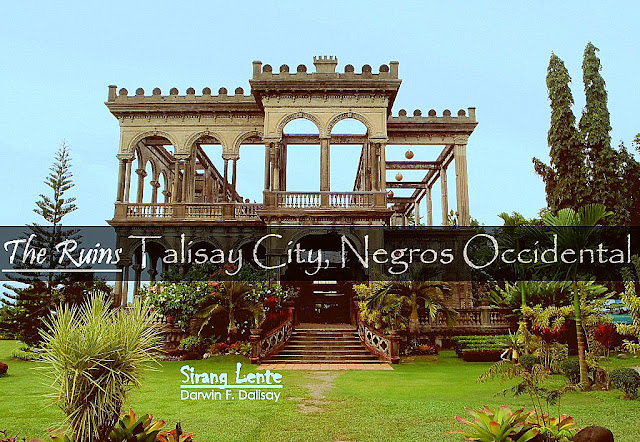
The Ruins, in Talisay City, was the largest residential mansion built then. This mansion belongs to sugar baron Don Mariano “Anoy” Ledesma Lacson (1865-1948.) Built after the death of his wife Maria Braga (1911) and served as the residence of their unmarried children. But, in the early part of World War II, USAFEE and then guerrilla fighters built this mansion to prevent the Japanese forces from making this structure their headquarters. It was burning for three days, leaving no traces of its glorious past, but still, the effort of the workers paid off because its gorgeous RUINS are still standing and part of our today.
How to Get to The Ruins, Bacolod:
- By Air: Book a flight from Manila to Bacolod Airport. Then, take a taxi directly to its entrance.
- Public Transport: In Bacolod, you can take a jeepney with Batad-Libertad route. Ask the driver to drop you off at the Pepsi Bottling Plant. Then, charter a tricycle to The Ruins.
You Need to Know about The Ruins:
- Address/Location: Talisay City, Negros Occidental.
- Opening Hours: 9AM to 8PM
- Entrance Fee: 150 Pesos for adults, 100 for senior citizens, and 80 for kids.
Backpacking in The Ruins, Talisay City:
I was at the entrance to The Ruins when I saw its artistic and gigantic shadow. With my backpack, of course, on my back, that’s why it’s called backpack; it’s really on my back, right? Upon paying the entrance fee, I headed to the fountain area, sat on the bench, and stared at the structure for 20 minutes. The ambiance was relaxing because the area is surrounded by gorgeous landscape. Below are the facts written on the printed materials on the wall - courtesy of the Management.
This structure is known worldwide as one of the best ruins of modern times because of its gorgeous Italianate architecture with neo-Romanesque columns. Many names circulated, like Balay Daco, Simento nga Balay, Mansyon, Palasyo, Lacson Mansion, Balay ni Anoy, and many more, but one name best describes the structure – the management.


Structure, Design, and Architecture: One of the sons, Felipe, supervised the construction of this mansion. He ensured that the mixtures of concrete they were using were all A-grade. The pouring plan was precisely followed, and he made sure that he and the builders ran their hands to the walls, posts, columns, and arches, and they should feel the marble-like effect on that. Before pouring, he even gathered more people to ensure that the process would be done non-stop until the whole structure was complete. The electric wires used in this structure are the same as what we use today. At the Veranda, there were no wires exposed at the ceiling lights. This is just one proof that the knowledge of the builders before was remarkable.
 |
| Stunning photo of The Ruins in Bacolod. |

The flooring used in the mansion was long-span, 2-inch thick hardwood, running from the main entrance facing the fountain to the end of the dining room with no joints. The woods were about a meter wide and were approximately 20.5 meters long. They initially poured three drums of gasoline to ignite the floors of the mansion, but nothing happened. Upon returning, they mixed two drums of gasoline with four drums of used oil and poured the mixture on the floors of the mansion.
The rain gutters at the mansion's top are concrete and formed like canals. Rainwater runs to the back portion of the mansion, where two large downspouts lead the water to a steel pipe to the ground, where all the water is collected and used for washing their clothes.
During my visit, I was fed with a lot of historical facts. After my visit, I rode in a tricycle and returned to the PEPSI plant by the highway. Crossed and walked to the terminal nearby. Took a ride in a UV Express van to the airport. Checked in. Waited for my flight. And flown back to Manila. READ: Solo-Backpacking in Negros Occidental and Ilo-Ilo
